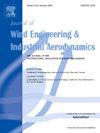Scaling wind loads for incremental dynamic analysis applications
IF 4.9
2区 工程技术
Q1 ENGINEERING, CIVIL
Journal of Wind Engineering and Industrial Aerodynamics
Pub Date : 2025-05-02
DOI:10.1016/j.jweia.2025.106116
引用次数: 0
Abstract
Incremental Dynamic Analysis is a powerful tool for the performance assessment of structures where a full range of responses can be mapped. Currently, an open discussion among researchers is the scaling of wind loads at increasing hazard intensities. In common practice, local aerodynamic pressure data from wind tunnel testing are normalized with respect to the mean wind velocity. Then, the value is linearly scaled up to provide wind loads at considered limit states. The main issue in the linear scaling of winds is the non-consideration of cross-correlation between different time histories and the mean wind velocity. To address this issue, the Wieringa gust model is applied to account for the dependency of gustiness on mean wind speed, thereby updating the scaling coefficients for both mean and turbulent wind components. This methodology is demonstrated through the application of wind IDA on a high-rise steel hospital in Montreal, Canada. The building is designed to meet the code requirements for wind and earthquake loads. Finite element models that incorporate geometrical and material nonlinearities of building's lateral force-resisting systems are developed in OpenSees. These nonlinear models are used to analyze the impact of linear gust scaling on the building's performance under varying wind intensities.
缩放风荷载增量动态分析应用
增量动力分析是一个强大的工具,为结构的性能评估,其中全范围的响应可以映射。目前,研究人员之间的一个公开讨论是风荷载在增加危险强度下的比例。在通常的实践中,来自风洞试验的局部气动压力数据相对于平均风速是归一化的。然后,该值线性放大,以提供在考虑的极限状态下的风荷载。风的线性标度的主要问题是没有考虑不同时程和平均风速之间的相互关系。为了解决这一问题,采用Wieringa阵风模型来考虑阵风对平均风速的依赖,从而更新了平均风分量和湍流风分量的标度系数。通过在加拿大蒙特利尔的一家高层钢结构医院中应用风力IDA来证明这种方法。该建筑的设计满足规范对风和地震荷载的要求。在OpenSees中开发了包含建筑物横向抗力系统的几何和材料非线性的有限元模型。这些非线性模型用于分析在不同风强度下线性阵风尺度对建筑物性能的影响。
本文章由计算机程序翻译,如有差异,请以英文原文为准。
求助全文
约1分钟内获得全文
求助全文
来源期刊
CiteScore
8.90
自引率
22.90%
发文量
306
审稿时长
4.4 months
期刊介绍:
The objective of the journal is to provide a means for the publication and interchange of information, on an international basis, on all those aspects of wind engineering that are included in the activities of the International Association for Wind Engineering http://www.iawe.org/. These are: social and economic impact of wind effects; wind characteristics and structure, local wind environments, wind loads and structural response, diffusion, pollutant dispersion and matter transport, wind effects on building heat loss and ventilation, wind effects on transport systems, aerodynamic aspects of wind energy generation, and codification of wind effects.
Papers on these subjects describing full-scale measurements, wind-tunnel simulation studies, computational or theoretical methods are published, as well as papers dealing with the development of techniques and apparatus for wind engineering experiments.

 求助内容:
求助内容: 应助结果提醒方式:
应助结果提醒方式:


